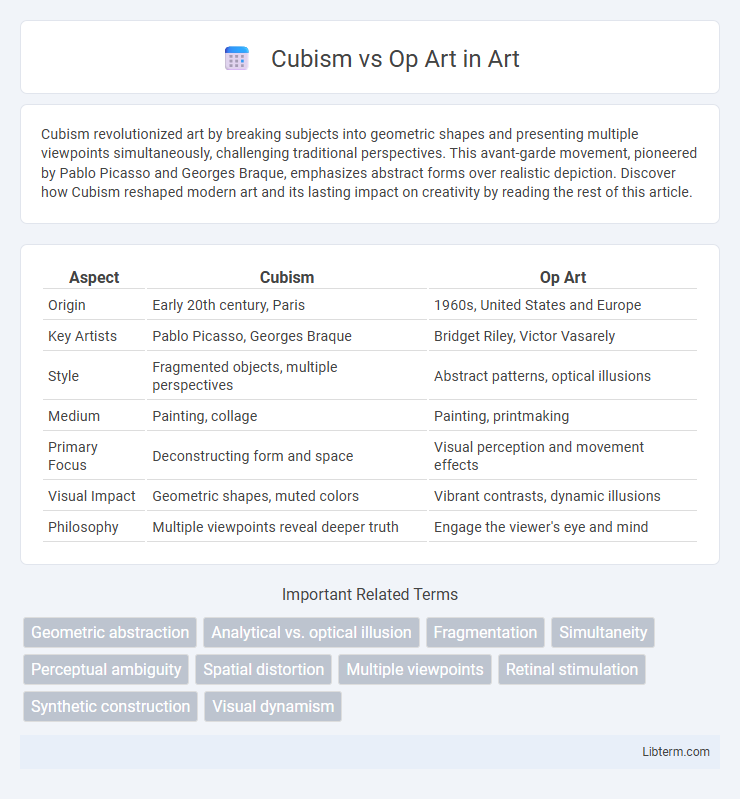Cubism revolutionized art by breaking subjects into geometric shapes and presenting multiple viewpoints simultaneously, challenging traditional perspectives. This avant-garde movement, pioneered by Pablo Picasso and Georges Braque, emphasizes abstract forms over realistic depiction. Discover how Cubism reshaped modern art and its lasting impact on creativity by reading the rest of this article.
Table of Comparison
| Aspect | Cubism | Op Art |
|---|---|---|
| Origin | Early 20th century, Paris | 1960s, United States and Europe |
| Key Artists | Pablo Picasso, Georges Braque | Bridget Riley, Victor Vasarely |
| Style | Fragmented objects, multiple perspectives | Abstract patterns, optical illusions |
| Medium | Painting, collage | Painting, printmaking |
| Primary Focus | Deconstructing form and space | Visual perception and movement effects |
| Visual Impact | Geometric shapes, muted colors | Vibrant contrasts, dynamic illusions |
| Philosophy | Multiple viewpoints reveal deeper truth | Engage the viewer's eye and mind |
Introduction to Cubism and Op Art
Cubism, pioneered by Pablo Picasso and Georges Braque in the early 20th century, emphasizes fragmented forms and multiple perspectives within a single plane, challenging traditional representation and perception in art. Op Art, originating in the 1960s with artists like Bridget Riley and Victor Vasarely, focuses on optical illusions and visual stimuli through patterns, contrasts, and geometric shapes to evoke movement and depth. Both movements revolutionized modern art but explored perception through distinct visual languages: Cubism deconstructs objects, while Op Art manipulates viewer perception.
Historical Origins of Cubism
Cubism emerged in the early 20th century, pioneered by Pablo Picasso and Georges Braque in Paris around 1907-1914. This art movement revolutionized traditional perspectives by fragmenting objects into geometric shapes and presenting multiple viewpoints simultaneously. Its origins are deeply rooted in the influence of African tribal masks and Cezanne's exploration of geometric simplification.
Emergence and Development of Op Art
Op Art emerged in the 1960s as a distinct movement focused on optical illusions and visual perception, contrasting with Cubism's early 20th-century emphasis on fragmented forms and multiple perspectives. Key figures like Bridget Riley and Victor Vasarely developed intricate patterns and color contrasts that created dynamic visual effects, expanding the exploration of geometric abstraction initiated by Cubism. The development of Op Art was influenced by advances in scientific understanding of vision, pushing the boundaries of how art interacts with human optical processing.
Key Artists in Cubism
Key artists in Cubism include Pablo Picasso, Georges Braque, and Juan Gris, who pioneered the movement by breaking objects into geometric shapes and multiple perspectives. Picasso's "Les Demoiselles d'Avignon" and Braque's analytical Cubism works exemplify this revolutionary approach to form and space. Unlike Op Art, which focuses on optical illusions and visual perception, Cubism emphasizes fragmentation and abstraction to depict subjects from diverse viewpoints simultaneously.
Influential Figures in Op Art
Bridget Riley and Victor Vasarely are pivotal figures in Op Art, pioneering optical illusions that challenge visual perception through geometric patterns and contrasting colors. Riley's dynamic compositions create movement and vibration in flat surfaces, while Vasarely's work integrates mathematical precision with vibrant, three-dimensional effects. Their contributions established Op Art as a distinct movement emphasizing visual experience and perceptual interaction.
Core Principles of Cubism
Cubism emphasizes fragmented objects, multiple viewpoints, and geometric shapes to depict subjects beyond traditional perspective, challenging the illusion of depth and form. The movement seeks to represent reality as a composite of simultaneous perspectives, breaking down objects into abstracted, interlocking planes. Core principles include flattening the picture plane, reducing color palettes, and prioritizing structure over naturalistic representation, distinguishing it from the optical illusions and kinetic effects central to Op Art.
Defining Characteristics of Op Art
Op Art is defined by its use of optical illusions, geometric shapes, and contrasting colors to create visual effects that appear to move or vibrate. The movement focuses on precise patterns, repetition, and the manipulation of light and shadow to engage viewers' perception. Unlike Cubism's fragmented forms and multiple viewpoints, Op Art relies on minimalistic designs to produce dynamic and often dizzying visual experiences.
Visual Techniques: Cubism vs Op Art
Cubism employs fragmented geometric shapes and multiple perspectives to depict subjects in a deconstructed, abstract form, emphasizing spatial depth and volume through intersecting planes. Op Art utilizes precise, repetitive patterns and contrasting colors to create optical illusions of movement, vibration, or warping, engaging the viewer's visual perception dynamically. While Cubism disrupts traditional representation by breaking objects into facets, Op Art manipulates visual stimuli to produce flickering and pulsating effects without representational content.
Cultural Impact and Legacy
Cubism revolutionized early 20th-century art by breaking traditional perspective and influencing movements like Surrealism and Futurism, reshaping visual culture and modern art foundations. Op Art emerged in the 1960s, pioneering optical illusions and visual perception studies, significantly impacting graphic design, advertising, and digital media aesthetics. Both movements challenged viewers' visual experiences, leaving enduring legacies that continue to inspire contemporary art and design innovation worldwide.
Conclusion: Comparing Cubism and Op Art
Cubism deconstructs objects into geometric shapes to depict multiple perspectives simultaneously, emphasizing form and structure. Op Art relies on optical illusions and precise patterns to create visual movement and depth, prioritizing viewer perception. Comparing both, Cubism centers on conceptual representation while Op Art focuses on sensory stimulation, highlighting distinct artistic goals within modern art.
Cubism Infographic

 libterm.com
libterm.com